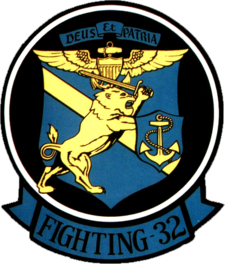VFA-32
| Strike Fighter Squadron 32 | |
|---|---|

VFA-32 insignia
|
|
| Active | 1 February 1945 – present |
| Country | United States of America |
| Branch | |
| Type | Strike Fighter |
| Part of | Carrier Air Wing THREE (CVW-3) |
| Garrison/HQ | Naval Air Station Oceana |
| Nickname(s) | "Fighting Swordsmen" |
| Motto(s) | Deus et Patria ("God and Country") |
| Engagements |
World War II Korean War Vietnam War Gulf of Sidra incident (1989) Gulf War Operation Provide Promise Operation Deny Flight Operation Southern Watch Operation Deliberate Force Operation Desert Fox Iraq War Operation Enduring Freedom |
| Aircraft flown | |
| Fighter |
F6F Hellcat F8F Bearcat F4U Corsair F-9 Cougar F-8 Crusader F-4B Phantom II F-14 Tomcat F/A-18F Super Hornet |
Strike Fighter Squadron 32 (VFA-32), nicknamed the "Fighting Swordsmen" are a United States Navy strike fighter squadron presently flying the F/A-18F Super Hornet and based ashore at Naval Air Station Oceana. Their radio callsign is Gypsy and their tail code is AC.
Their mission is: "Strike Fighter Squadron 32, as a part of United States Naval Aviation, utilizes the F/A-18F aircraft to project power ashore and at sea, to defend the Fleet against air and sea threats and to carry out all other missions which may be assigned by cognizant authority."
Originally, the squadron used the Fighting Three Felix the Cat symbol and called themselves the "Crazy Cats" because so many pilots were from Fighting Three. At one time, the squadron was known as the "White Lightning." In 1950, the squadron adopted the insignia of a traditional heraldry lion under Naval Aviation wings of gold and the motto "Deus et Patria" that has endured with only slight modernization through today. The VF-32 squadron radio callsign is "Gypsy" and most alumni refer to themselves as "Gypsies". The squadron picked up the nickname Swordsmen after it switched to the F-8 Crusader and added a sword to the lion's hand.
VFA-32 was established as Bombing Fighting Three (VBF-3) on February 1, 1945, flying the F6F Hellcat, when it was split off from VF-3, the famed Felix squadron. Fritz Wolf, a former member of the American Volunteer Group (AVG) or Flying Tigers, was assigned as the first VBF-3 commanding officer. At the time, U.S. Navy carriers were closing on the Japanese home islands and were facing aggressive Kamikaze attacks. VBF-3 was assigned to Carrier Air Group THREE on board USS Yorktown in the Pacific theater. On 16 February 1945, VBF-3 pilots became the Navy's first carrier-based pilots to strike the Japanese islands. During the heavy action on that day, the squadron shot down 24 Japanese aircraft, earning the Presidential Unit Citation.
...
Wikipedia
